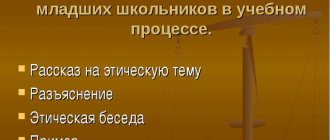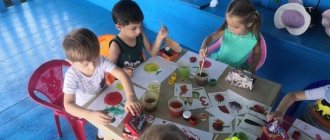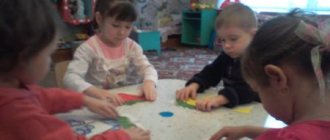From the author
The purpose of this book is the moral education of a child, his spiritual development, and the task is to develop in children the best qualities characteristic of a Russian person: high spirituality, kindness, responsiveness, hard work, respect for elders, mercy, respect for nature, patience, compassion, courage . Preschoolers can be introduced to Russian culture and its history in the form of a conversation about oral folk art, painting, music, or familiarization with the life, rituals and traditions of the Russian people.
The book presents more than 150 detailed lesson notes for preschoolers of all age groups, compiled on the basis of works of Russian folklore. They will help the teacher, not in an edifying, but in an entertaining way, teach children to love their people, their homeland, respect its past, love each other and take care of their native nature.
How did the city of Myshkin appear? How did the soldier Semyon fight the French? What herbs can be used to cure a sick sparrow? How to build a hut for a fox? Is it possible to make the evil Baba Yaga a kind old lady, and teach the lazy Miliktrisa Kirbitevna to work? Is every guest a joy for the hosts? And is it true that “good will not die, but evil will disappear”?
This book will tell you and your students about this and much more.
The program contains an annual cycle of classes - 36 for each age group of kindergarten, as well as an additional one - of 13 classes in the creative activity of children in the pre-school group. Classes last from 20 to 30 minutes. I would like to draw attention to the additional cycle of classes on artistic creativity “Soon the fairy tale is told, but not soon the deed is done.” It is built on a single plot and is perceived by children as one whole. Classes are held once a week for 30 minutes. They are quite voluminous and provide the opportunity to complete them in your free time during the week. This approach eliminates the need to rush and teaches children to occupy their leisure time with work. Sometimes children may come to the workshop simply to admire the model being gradually put together or to help a friend. This maintains interest in the plot and in the work itself, which makes it more joyful and creative. I would like to consider the fruits of such work not to be copied paintings, not special successes in needlework, but to receive joy from work, the desire to create beauty and give it to others, the ability to work together, the willingness to help, the feeling that everyone’s efforts are a contribution to the common cause in the name of of good.
The “Warm Hut” program was tested in preschool educational institution 21 “Rainbow” in the city of Vysokovsk, Moscow region, and was created in the process of practical work with children. I would like to thank everyone who supported me in this work, provided practical assistance and greatly contributed to the emergence of this program. I would like to express special gratitude to my daughters, Nadezhda and Olesya.
Spiritual and moral education of children of senior preschool age in kindergarten
Project “Spiritual and moral education of preschool children”
A spiritual person thinks with his own thoughts, but feels with the feelings of others... .
(L.N. Tolstoy) The spiritual and moral education of the younger generation is a direction that life itself has currently put forward as a priority in the education system.
For a long time in domestic pedagogy, education has been closely associated with the development of the spiritual and moral sphere of creating a person who is thinking, virtuous, merciful, conscientious, who believes in the possibility of improving the world and people, honest, hardworking, modest, respectful, and therefore responsible. Preschool age is characterized by great opportunities for the moral education of children. It is during this period that the child is introduced to culture, to universal human values, and such spiritual principles as love for family and friends, a sense of duty, the desire for virtue, conscientiousness and justice are formed. The formation of moral and ethnic values of one’s native culture from early childhood is the only, and therefore the surest, way to cultivate morality and spirituality. The content of spiritual and moral education includes: • Events in the flow of time: calendar dates, dates of the Orthodox and agricultural calendars, events in the life of a family, city, region. • The fates of people in history (close to the child, participants in historical events). • Development of folk culture and civilization: decorative and applied arts, painting, architecture, costume, household items, equipment, weapons. • The role of events, people, culture, values in the life of the people and the country. The purpose of education is the development of the moral qualities of the child’s personality. Objectives of education: • Cognitive:
1. Create conditions for the child to demonstrate a caring, merciful attitude towards others, to demonstrate the ability to empathy, joy and adequate expression of these feelings.
2. Form impressions about the historical and cultural traditions of the people through theater, games, and fairy tales. 3. Introduce children into the circle of the main Orthodox holidays, show their close and organic connection with folk life, introduce them to the basics of the spirituality of the people and the traditional way of life, as well as the peculiarities of preparing and holding holidays, awaken a sense of belonging to the traditions of our people. 4. Introduce the simplest Orthodox concepts associated with calendar dates, an explanation of their meaning, essence and value in the life and culture of Russians. 5. To form children’s ideas about such concepts as shame, conscience, forgiveness, reconciliation, mercy, honesty, kindness, love. 6. Introduce children to the traditional cuisine of the Orthodox holiday (pancakes, Easter cakes, cottage cheese Easter, eggs, name day pies). 7. To form in children initial ideas about the spiritual world, to introduce basic religious concepts (Nativity and Resurrection of Jesus Christ) • Educational:
1. To cultivate love and respect for the Fatherland: its people, culture, history, shrines, folklore, traditions of the people.
2. To instill in the child a desire to help others, to be truthful, hardworking, and fair. 3. Foster respect for the moral standards of Christian morality. Learn to distinguish between good and evil, good and bad deeds, forgive insults, be responsive, attentive to peers and elders. • Developmental:
1. Develop the intellectual abilities of children;
2. Improve speech: vocabulary, expressiveness, structure and correct construction of phrases; functions (dialogue, descriptive, narrative evidentiary); 3. Develop thinking: analyzing, associative, dialectical; 4. Develop imagination: reproducing, recreating creative; 5. Develop the emotional-volitional sphere: (culture, spiritual response) Didactic means: • Traditions, rituals of folk holidays and the life of Russians; • Epics, fairy tales, proverbs (folklore); • Folk toys; • Houseware; • Items of decorative and applied art; • Books: encyclopedias, booklets, children's fiction on the pages of history; • Photos; • Reproductions, illustrations;; • Schemes, models, symbols (heraldry); • Video, audio products. Methods of working with children: 1. Visual: showing visual demonstration material, excursions, observations, conducting didactic games, watching video materials. 2. Verbal: Presentation of material by the teacher, reading literary works, asking riddles, learning poetry. 3. Practical: Organization of productive activities, games of various types, holidays and entertainment, work activities. Forms of work with parents: • Diagnostic: 1. Questioning. 2. "At the round table." • Informational and methodological: 1. Information stands. 2. Thematic parent meetings. 3. Individual consultations and conversations. 4. Open showings. 5. Production of folders - slides. • Cultural - mass character: 1. Holidays and entertainment. 2. Exhibitions of folk and applied arts. With teachers and staff of preschool educational institutions: 1. consultations; 2. teacher councils, workshops; 3. excursions to the Temple; 4. conversations, debates; 5. selection of works of art with a spiritual and moral orientation for working with children; 6. questioning and testing; 7. preparation and conduct of morning classes. At matinees, there is a traditional holiday dish: Easter cake - Easter cake, Christmas - candy, Maslenitsa - pancakes, etc. The atmosphere of play and celebration, fun, food is perceived by children as an exciting educational activity. It should be noted that during the educational process, teachers have an excellent opportunity to form and direct the moral component of a child’s character. A special role in introducing a child to folk culture is played by folk holidays as a means of expressing national character, a vibrant form of recreation for adults (teachers and parents) and children, united by joint actions and common experiences. Optimal for spiritual and moral education in kindergarten is to hold seasonal musical and play holidays: in the fall - “Fair”; in winter - “New Year”, “Christmas”, “Christmastide”, “Defenders of the Fatherland”. "Maslenitsa"; in the spring - “Mother’s Day”, “Magpies”, “Easter”, “Nobody is forgotten and nothing is forgotten”, “Name Day Birches” (Trinity). Children, together with adults, explore the features of each national holiday. Older preschoolers establish its relationship with seasonal changes in nature, with the work of ancestors in the past and adults in the present, as well as with important dates and events in public life. A characteristic feature of the work to form a spiritual and moral attitude towards cultural heritage and a sense of belonging to it is the introduction of children to peasant culture and way of life. Peasant art enters the life of a modern child along with folk songs, fairy tales, and epics, which is why it is so close and understandable to him. Children of senior preschool age get an idea of the material from which objects of folk and applied art are made. Teachers involve children in the process of making folk toys and other objects, during which children acquire skills in working with artistic materials and the habit of making pleasant and useful things for people with their own hands. Teachers, parents, workers of cultural institutions introduce children to various types of decorative arts (products made of wood, clay, paper, cardboard, sewing, embroidery, weaving, with their everyday and aesthetic purposes. Educators help to understand how people’s favorite activities are related to natural features edges. For example, in Central Russia - this is wood carving, making pottery as necessary household items. Adults introduce children to bells and bells, their purpose. Older preschoolers are told about the role of the bell in the life of their ancestors - to notify about a holiday, a fire, the approach of an enemy , about the arrival of a distinguished guest. The work of moral education does not end with the lesson, because then the children tell their parents what they liked, share food, congratulate their friends and relatives, show drawings at home, compile a photo album about the holidays with their teachers. Often there is a need and in preliminary work with the children, especially before the holidays of Christmas, Easter, and St. Nicholas. Children are read works of fiction for the holiday, taught poetry, and talked about family traditions of the Orthodox holiday. In conclusion, I would like to note: this concept of the work of spiritual and moral education of preschool children allows: • To form a harmonious, spiritually healthy personality of the child. • Develop children's interpersonal communication skills from a position of equality, respect, and mutual understanding. • To cultivate through the means of theatrical and musical art feelings of patriotism, mercy, love of truth, striving for good and rejection of evil
We recommend watching:
Summary of the conversation in the senior group about charity and mercy Project “London”. English in kindergarten Short-term New Year's project for children 5-7 years old. Santa Claus and his friends Short-term information and educational project “About skiing” for older children
Similar articles:
Moral and environmental education of older preschoolers






